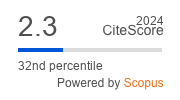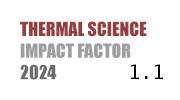THERMAL SCIENCE
International Scientific Journal
Thermal Science - Online First
online first only
Evaluation of refrigerant oil separators for screw chiller
ABSTRACT
Effective refrigerant and oil separation is must for reliable and energy efficient chiller operation. Type A is a conventional oil separator design having a larger shell diameter and single refrigerant outlet connected to condenser using a discharge piping. Type B is novel oil separator design having a smaller shell diameter and two refrigerant outlets connected to the condenser. Computational fluid dynamics simulation of both designs is done for comparing oil separation efficiencies, velocity distribution, pressure drop and oil droplet trajectories. The simulated pressure drop matches closely (< 5 %) with experimental results in both designs. Type A design has higher (10912 Pa) pressure drop than Type B design. Simulation shows both the designs have almost equivalent oil separation efficiency at and above 25 μm oil droplet sizes. Below 25 μm oil droplet sizes, the Type B design has better oil separation efficiency. Chiller with Type B design has better oil circulation rates in liquid refrigerant than the chiller with Type A design at maximum flow rate condition. Therefore, Type B oil separator is found to be superior in performance (lower pressure drop and lower oil circulation rates) at lesser cost. Chiller with Type B oil separator is having 0.5 % more refrigeration capacity, 1.6 % higher Coefficient of performance and 1.1 % lower power consumption than chiller with Type A oil separator.
KEYWORDS
PAPER SUBMITTED: 2025-01-22
PAPER REVISED: 2025-02-14
PAPER ACCEPTED: 2025-02-16
PUBLISHED ONLINE: 2025-07-05
- Haider, S.A. et al., Oil Circulation Ratio Prediction in a Vapor Compression System Using a Discharge Side Oil Separator and Mass Flow Correction, International Journal of Refrigeration, Vol. 169 (2025), pp. 69-79, DOI: doi.org/10.1016/j.ijrefrig.2024.09.02
- API 12J: 2008, Specification for Oil and Gas Separators, The American Petroleum Institute, Eighth edition, (2008)
- Arnold K. and Stewart M., Two-Phase Oil and Gas Separation, in Surface Production Operations: Design of Oil Handling Systems and Facilities, Elsevier, (1999), Chapter 4, pp. 101-134, DOI: doi.org/10.1016/B978-088415821-9/50005-1
- Jekel, T., et al., Gravity Separator Fundamentals and Design, IIAR 2001 Ammonia Refrigeration Convention & Exhibition, Long Beach, CA, USA, (2001), pp. 1-23
- Wiencke, B., Fundamental Principles for Sizing and Design of Gravity Separators for Industrial Refrigeration, International Journal of Refrigeration, Vol. 34, Issue 8, (2011), pp. 2092-2108, DOI: doi.org/10.1016/j.ijrefrig.2011.06.011
- Bothamley M., Gas/Liquid Separators: Quantifying Separation Performance - Part 1, Oil and Gas Facilities, (2015), pp. 22-29, DOI: 10.2118/0813-0021-OGF
- Bothamley M., Gas/Liquid Separators: Quantifying Separation Performance - Part 2, Oil and Gas Facilities, (2015), pp. 35-47, DOI: 10.2118/1013-0035-OGF
- Xu, J., and Hrnjak, P. S., Formation, Distribution, and Movement of Oil Droplets in The Compressor, International Journal of Refrigeration, Vol. 93, (2018), pp. 184-194, DOI: 10.1016/j.ijrefrig.2018.06.020
- Xu, J., and Hrnjak, P. S., Coalescing Oil Separator for Compressors, International Journal of Refrigeration, Vol. 106, (2019), pp. 41-53, DOI: doi.org/10.1016/j.ijrefrig.2019.06.027
- Laleh A., et al., Design and CFD Studies of Multiphase Separators - A Review, Canadian Society for Chemical Engineering, Vol. 90, (2012), pp. 1547-1560
- Laleh A., et al., Computational Fluid Dynamics-Based Study of an Oilfield Separator-Part I: A Realistic Simulation, Society of Petroleum Engineers, Oil and gas facilities, Vol. 90, (2012), pp. 57-68, DOI: 10.1002/cjce.20665
- Gaffarkhah A, et al., Application of CFD for Designing Conventional Three Phase Oilfield Separator, Egyptian Journal of Petroleum, Vol. 26, Issue 2, (2017), pp. 313-420, DOI: 10.1016/j.ejpe.2016.06.003
- Oliveira J. Jr., et al, Numerical Simulation of Demister Equipment for Application in Gravitational Separators, Proceedings of COBEM 2009, 20th International Congress of Mechanical Engineering, Brazil (2009), pp. 1-8
- Feng, J. M., et al., Investigation of the Oil-Gas Separation in a Horizontal Separator for Oil Injected Compressor Units, Proceedings of the Institution of Mechanical Engineers, Part A Journal of Power and Energy, Vol. 222, (2008), pp. 403-412, DOI: 10.1243/09576509JPE550
- Wang Zhongyia, et al., The Analysis of Internal Flow Field in Oil-Gas Separator, Procedia Engineering 15, (2011), pp. 4337-4341, DOI: 10.1016/j.proeng.2011.08.814
- Eastwick C. et al, Using CFD to Improve Aero-Engine Air/Oil Separator Design, ASME PVP2002-1554, (2002), pp. 215-220, DOI: 10.1115/PVP2002-1554
- ASHRAE 41.4, Standard Method for Measurement of Proportion of Lubricant in Liquid Refrigerant, (1996), American Society of Heating, Refrigerating and Air-Conditioning Engineers
- NABL-141, Guidelines for Estimation and Expression of Uncertainty in Measurement, Issue 02, (2000), National Accreditation Board for Testing and Calibration Laboratories India
- NABL-174, Sample Calculations for Uncertainty of Measurement in Electrical Testing, Issue 02, (2004), National Accreditation Board for Testing and Calibration Laboratories India

